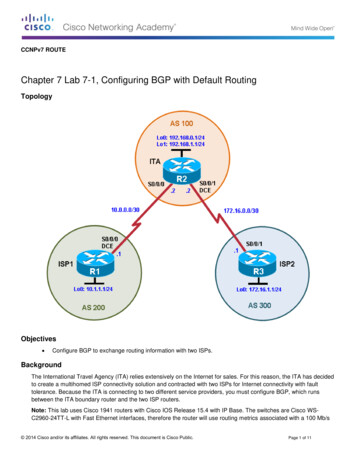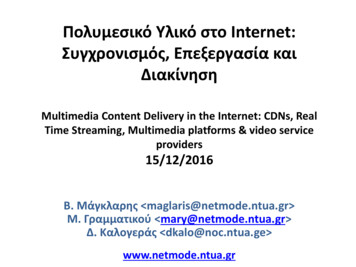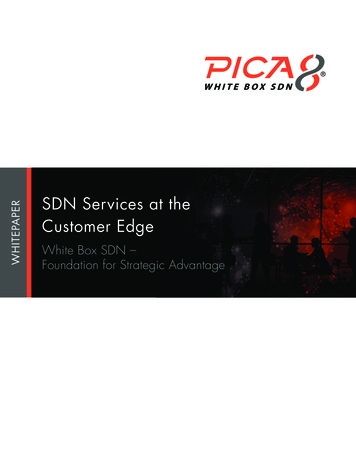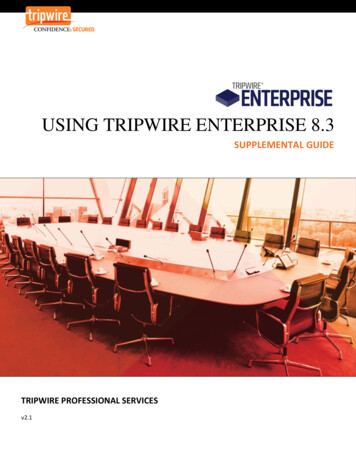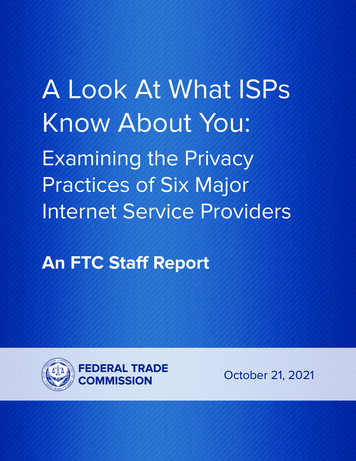
Transcription
A Look At What ISPsKnow About You:Examining the PrivacyPractices of Six MajorInternet Service ProvidersAn FTC Staff ReportOctober 21, 2021
A Look At What ISPsKnow About You:Examining the Privacy Practices of Six MajorInternet Service ProvidersAn FTC Staff ReportOctober 21, 2021FEDERAL TRADE COMMISSION
Table of ContentsExecutive Summary. iI.Introduction . 1II.Legal Framework Applicable to ISP Privacy. 4A.Historical Developments. 4B.Legal Framework Applicable to ISPs Today. 6III.Background Information About Order Recipients . 10IV.Information Obtained From Our Study. 14A.Core Services . 15B.Other Services Offered to Consumers . 17C.Advertising Services . 18D.V.1.Marketing Their Own Products and Services . 202.Advertising Third-Party Products and Services . 223.Other Services Offered to Businesses . 244.Contractual Limitations on Use and Sharing . 26Privacy Practices . 261.Opacity . 262.Illusory Choices . 273.Lack of Meaningful Access . 304.Data Retention and Deletion . 315.Accountability . 32Observations . 33A.Many ISPs in our Study Amass Large Pools of Sensitive Consumer Data . 33B.Several ISPs in Our Study Gather and Use Data In Ways Consumers Do Notand Could Cause Them Harm . 34
VI.C.Although Many ISPs in Our Study Purport to Offer Consumers Choices,These Choices are Often Illusory . 39D.Many ISPs in Our Study Can Be At Least As Privacy-Intrusive as LargeAdvertising Platforms. 42Conclusion . 44APPENDIX A: Text of the Model Order . A-1APPENDIX B: Illustrative List of Segments . B-1
Examining the Privacy Practices of Six Major Internet Service ProvidersExecutive SummaryThe importance of the internet in the daily lives of consumers cannot be overstated. In itsrelatively brief existence, it has become a vital tool for communication, information, commerce, andentertainment. Approximately 93% of adults in the United States use the internet, 1 and the averageconsumer spends six hours and fifty-six minutes online each day. 2 As the direct gateways to thisessential and ubiquitous tool, internet service providers (“ISPs”) can monitor and record their customers’every online move, giving them the ability to surveil consumers and amass large amounts of informationon them as they go about their daily lives. In addition to providing internet, voice, and cable access,these gatekeepers have also become major players in content creation and ad monetization.Over the past few decades, the telecommunications industry has evolved into verticallyintegrated platforms that provide internet, cable, content, distribution, advertising, and analytics—all ofwhich has increased the volume of information available about consumers, improved the industry’sinsights into consumers’ behaviors, and strengthened the persistence of identifiers capable of trackingusers across platforms and assets. For example, in 2011, Comcast acquired NBC Universal, marking thefirst time a cable company controlled a major broadcast network. 3 Verizon purchased AOL in 2015,combining one of the biggest mobile network providers with a leading content producer, and Yahoo in2017, creating a diverse house of more than fifty media and technology brands. 4 And in 2020, Amazonreceived approval to deploy and operate 3,236 satellites, allowing it to deliver satellite-based broadbandservices in the United States. 5 This rapid consolidation has allowed ISPs to access and control a muchlarger and broader cache of consumer data than ever before, without having to explain fully theirpurposes for such collection and use, much less whether such collection and use is good for consumers.Internet/Broadband Fact Sheet, PEW RESEARCH CTR. (Apr. 7, 2021), ernet-broadband/.1Simon Kemp, Digital 2021 April Global Statshot Report, DATAREPORTAL (Apr. 21, 1-april-global-statshot.2Tim Arango & Brian Stelter, Comcast Receives Approval for NBC Universal Merger, N.Y. TIMES (Jan. 19, media/19comcast.html.3See Ben Rooney, Verizon Buys AOL for 4.4 billion, CNN BUS. (May 12, erizon-buys-aol/index.html; Press Release, Verizon, Verizon CompletesYahoo Acquisition, Creating a Diverse House of 50 Brands Under New Oath Subsidiary (June 13, 50-brands-under-newoath-subsidiary. In September 2021, private equity firm Apollo Global Management acquired Yahoo (formerly known asVerizon Media Group, itself formerly known as Oath) from Verizon. See Brian Heater & Ingrid Lunden, Apollo CompletesIts 5B Acquisition of Verizon Media, Now Known as Yahoo, TECHCRUNCH (Sep. 1, wn-as-yahoo.4Amazon Staff, Amazon Receives FCC Approval for Project Kuiper Satellite Constellation, AMAZON (July 30, satellite-constellation.5FEDERAL TRADE COMMISSIONFT C.GOVi
Examining the Privacy Practices of Six Major Internet Service ProvidersIn August 2019, the Federal Trade Commission (“FTC” or “Commission”) issued identicalOrders to File Special Reports (“Orders”) under Section 6(b) of the FTC Act to the country’s six largestISPs (AT&T Mobility LLC, Cellco Partnership d/b/a Verizon Wireless, Charter CommunicationsOperating LLC, Comcast Cable Communications d/b/a Xfinity, T-Mobile US Inc., and Google FiberInc.)—comprising approximately 98.8 % of the mobile internet market 6—and three advertising entitiesaffiliated with these ISPs (AT&T’s Appnexus Inc.—rebranded as Xandr—and Verizon’s VerizonOnline LLC and Oath Americas Inc.—rebranded as Verizon Media). 7 Appendix A is a copy of the textof the Orders that the Commission issued to the ISPs and their affiliated entities. The Orders soughtinformation from these ISPs as to their data collection and use practices, as well as any tools provided toconsumers to control these practices.This report summarizes the information provided in response to the Commission’s Orders,including information gathered through follow-up questions and meetings. The companies’ narrativeresponses and several detailed data sets provide remarkable insight into how many of the ISPs 8 in ourstudy surveil consumers, use and disseminate consumer data, and the privacy implications of such useand dissemination. Based on this data, publicly-available materials, and the Commission’s longexperience with ISPs, this report highlights the ISP industry’s data surveillance and privacy practices.Key Findings1.Collection and UseIn general, many of the ISPs in the study collect and use information for four primary reasons:(1) to provide core communications services to consumers (internet, voice, video); (2) to provide otherservices to consumers (e.g., Internet of Things, and video or website content); (3) advertising; and (4) toprovide other services to businesses. The following findings relating to collection and use are notable: Some ISPs in Our Study Combine Data Across Product Lines. Three of the ISPs inour study revealed that they combine information they receive from consumers acrosstheir core services and at least some of their other services (e.g., TV and video streamingservices, home automation and security products, connected wearables, etc.). Some ISPs in Our Study Collect Data Unnecessary for the Provision of InternetServices. Some of the ISPs in our study collect additional data from their customers thatWireless Subscriptions Market Share by Carrier in the U.S., STATISTA (Apr. criptions/.6In May 2021, after the issuance of these Orders, Verizon announced that it was selling Verizon Media to private equity firmApollo Global Management. See Jordan Valinsky, Verizon Offloads Yahoo and AOL in 5 Billion Deal, CNN BUS. (May 3,2021), -sold-apollo/index.html.7Due to Sections 6(f) and 21(d)(1)(B) of the FTC Act prohibiting the Commission from disclosing trade secrets orcommercial or financial information that is privileged or confidential, the data discussed in this report is provided on ananonymous and aggregated basis. See 15 U.S.C. § 46(f) (2018); 15 U.S.C. § 57b-2 (2018).8FEDERAL TRADE COMMISSIONFTC.GOVii
Examining the Privacy Practices of Six Major Internet Service Providersis not necessary to provide ISP services in order to enhance their ability to advertise (e.g.,app usage history). A Few ISPs in Our Study Use Web Browsing Data to Target Ads. Two of the ISPs inour study stated that they use web browsing information to target ads to consumers, andanother reserves the right to use such information for advertising purposes. Many ISPs in Our Study Group Consumers Using Sensitive Characteristics toTarget Ads. Many of the ISPs in our study serve targeted ads across the internet onbehalf of third parties. In doing so, they place consumers into segments that often revealsensitive information about consumers, allowing advertisers to target consumers by theirrace, ethnicity, sexual orientation, economic status, political affiliations, or religiousbeliefs. Some ISPs in Our Study Combine Personal, App Usage, and Web Browsing Data.At least three ISPs in our study report combining consumers’ personal information, appusage information, and/or browsing information for advertising purposes. A Significant Number of ISPs in Our Study Share Real-Time Location Data WithThird-Parties. There is a trend in the ISP industry to offer real-time location data aboutspecific subscribers to the ISPs’ third-party customers.2.Privacy PracticesIn response to the Orders, the ISPs in our study detailed their notice and disclosure; consent andchoice; and access, correction, and deletion practices. The ISP industry’s privacy practices raiseconcerns in four key areas: Opacity. While several ISPs in our study tell consumers they will not sell their data,they fail to reveal to consumers the myriad of ways that their data can be used,transferred, or monetized outside of selling it, often burying such disclosures in the fineprint of their privacy policies. In addition, three of the ISPs in our study reserved theright to share their subscribers’ personal information with their parent companies andaffiliates, which seems to undercut the promises not to sell personal information. Illusory Choices. There is a trend in the ISP industry to purport to offer consumerssome choices with respect to the use of their data. However, problematic interfaces canresult in consumer confusion as to how to exercise these choices, potentially leading tolow opt-out rates. Lack of Meaningful Access. Although many of the ISPs in our study purported tooffer consumers access to their information, the information was often eitherindecipherable or nonsensical without context, potentially leading to low accessrequests.FEDERAL TRADE COMMISSIONFTC.GOViii
Examining the Privacy Practices of Six Major Internet Service Providers Data Retention and Deletion. While several of the ISPs in our study provided timeframes for deleting information, many asserted that they keep information as long as itis needed for a business reason. However, many ISPs in our study have the ability todefine (or leave undefined) what constitutes a business reason, giving them virtuallyunfettered discretion.ObservationsAs a result of the findings detailed above, we make the following four observations: Many ISPs in Our Study Amass Large Pools of Sensitive Consumer Data. SeveralISPs in our study and their affiliates collect significant amounts of consumer informationfrom the range of products and services that they offer. The vertical integration of ISPservices with other services like home security and automation, video streaming, contentcreation, advertising, email, search, wearables, and connected cars permits not only thecollection of large volumes of data, but also the collection of highly-granular data aboutindividual subscribers. Moreover, there is a trend in the ISP industry to combine thesubscriber data with additional information from third-party data brokers, resulting inextremely granular insights and inferences into not just ISP subscribers but also theirfamilies and households. Several ISPs in Our Study Gather and Use Data in Ways Consumers Do Not Expectand Could Cause Them Harm. While consumers certainly expect ISPs to collectcertain information about the websites they visit as part of the provision of internetservices, they would likely be surprised at the extent of data that is collected andcombined for purposes unrelated to providing the service they request—in particular,browsing data, television viewing history, contents of email and search, data fromconnected devices, location information, and race and ethnicity data. More concerning,this data could be used in a way that’s harmful to consumers, including by propertymanagers, bail bondsmen, bounty hunters, or those who would use it for discriminatorypurposes. Although Many ISPs in Our Study Purport to Offer Consumers Choices, TheseChoices are Often Illusory. Although many of the ISPs in our study purported to offerconsumers choices, some of these choices were not offered clearly and indeed, nudgedconsumers toward more data sharing. Many ISPs in Our Study Can be At Least As Privacy-Intrusive as LargeAdvertising Platforms. Despite ISPs’ relative size in a market dominated by Google,Facebook, and Amazon, the privacy challenges that permeate the advertising ecosystemmay be amplified by ISPs because: (1) many ISPs have access to 100% of consumers’unencrypted internet traffic; (2) several ISPs are able to verify and know the identity oftheir subscribers; (3) many ISPs can track consumers persistently across websites andgeographic locations; and (4) a significant number of ISPs have the capability to combineFEDERAL TRADE COMMISSIONFTC.GOViv
Examining the Privacy Practices of Six Major Internet Service Providersthe browsing and viewing history that they obtain from their subscribers with the largeamounts of information they obtain from the broad range of vertically integratedproducts, services, and features that they offer.FEDERAL TRADE COMMISSIONFTC.GOVv
Examining the Privacy Practices of Six Major Internet Service ProvidersI. IntroductionWe are in the midst of a global pandemic that has fundamentally changed our way of life. Asbusinesses, schools, governments, and communities have struggled to find new models for staying open,providing critical services, and keeping in touch, the importance of reliable internet has grown.Consumers are increasingly dependent on internet service providers (“ISPs”) to access essential servicesand communicate with others. 1 Indeed, as the global pandemic forced cities and states into mandatorylockdowns, ISPs increased their broadband subscriptions by nearly 8 million consumers during the lasttwo years, 2 with one ISP reporting historic broadband subscription numbers in the third quarter of2020. 3 Online shopping and e-commerce with U.S. retailers in 2020 increased by 44% from theprevious year, or over 263 billion, as consumers stayed home. 4 Video conferencing platforms sawtheir subscriptions dramatically increase. 5 Telehealth services soared upwards of 154% during the lastweek of March 2020 as compared to the same period as the previous year. 6 As of August 2020, nearly93% of households with school-age children reported engaging in some form of distance learning fromAs described in greater detail in Section III of this report, many ISPs in our study often provide services other than internetaccess to consumers. They provide bundles of services that might include internet, video, and voice. Additionally, manyISPs in our study might provide other services, such as connected cars, home security, or mobile money. This studyexamines how information about internet subscribers is collected, used, combined, and shared across products and servicesoffered by the ISPs in our study. As such, for purposes of this report, the term “ISP” refers to the entities that provide thispanoply of services, rather than focusing purely on the provision of internet access.1Press Release, Leichtman Research Grp., About 890,000 Added Broadband in 2Q 2021 (Aug. 18, 00-added-broadband-in-2q-2021/.2Michelle Caffrey, Comcast Q3 Earnings: Broadband Growth Hits All-Time High, but NBCU Struggles Weigh DownResults, BIZJOURNALS (Oct. 29, 2020), /10/29/comcast-q3-2020earnings-call.html.34Fareeha Ali, Charts: How the Coronavirus is Changing Ecommerce, DIGITAL COMMERCE 360 (Feb. 19, Heather Kelly, The Most Maddening Part About Working From Home: Video Conferences, WASH. POST (Mar. 16, ; Ella Koeze andNathaniel Popper, The Virus Changed the Way We Internet, N.Y. TIMES (Apr. 7, 07/technology/coronavirus-internet-use.html.5Lisa Koonin et al., Trends in the Use of Telehealth During the Emergence of the COVID-19 Pandemic–United States,January-March 2020, MORBIDITY AND MORTALITY WKLY. REP. (MMWR) (Oct. 30, 3a3.htm.6FEDERAL TRADE COMMISSIONFTC.GOV1
Examining the Privacy Practices of Six Major Internet Service Providershome. 7 Even when the pandemic subsides, studies predict that as many as a third of all U.S. companiesanticipate having half or more of their staff working from home or operating from remote locations. 8As the internet assumes an increasingly pervasive role in the most personal aspects of our lives,including telehealth and distance learning, the aggregation of data—along with the privacy of consumerdata in general—requires increased attention, especially for minority and low-income communities.According to Pew Research, as of February 2019, 79% of white U.S. adults are home broadband users,as compared to 66% of Black U.S. adults and 61% of Hispanic U.S. adults. According to more recentresearch from UCLA, Black and Hispanic households are 1.3 to 1.4 times as likely as white householdsto experience limited connectivity. 9 Low-income households are most impacted by digitalunavailability, with more than two in five having only limited access to a computer or the internet. 10 Wedid not study this issue, but observers report that these consumers may have fewer internet options 11 andsometimes those options include free or low-price services with fewer privacy protections. 12These concerns bring to the forefront privacy and competition issues associated with internetaccess. This report is based on materials provided by the country’s six largest ISPs comprisingKevin Mcelrath, Nearly 93% of Households with School-Age Children Report Some Form of Distance Learning DuringCOVID-19, U.S. CENSUS (Aug 26, 2020), ooling-during-the-covid-19pandemic.html.7Alexa Lardieri, One-Third of Companies Will Have Half of Workforce Remote Post-Pandemic, Study Finds, U.S. NEWS(Aug. 24, 2020), workforce-remote-post-pandemic-study-finds.8Paul M. Ong, Covid-19 and the Digital Divide in Virtual Learning, UCLA CTR. FOR NEIGHBORHOOD KNOWLEDGE 7 (Dec.9, 2020), ds/2020/12/Digital-Divide-Phase2 brief release v01.pdf.910Id.Kaleigh Rogers, Internet Service Providers Systematically Favor White Communities Over Communities of Color, VICE(Feb. 23, 2018), tiesover-communities-of-color (citing studies to support the point that “[i]nternet infrastructure is often built first in moreaffluent and more white communities, leaving lower income neighborhoods and neighborhoods with higher percentages ofpeople of color with fewer options”).11See, e.g., Benjamin Dean, The Heavy Price We Pay for “Free” Wi-Fi, THE CONVERSATION (Jan. 25, we-pay-for-free-wi-fi-52412 (noting that there’s a “longstanding trend in whichcompanies offer ostensibly free Internet-related products and services” but “[u]se is free on the condition that companiesproviding the service collect, store, and analyze users’ valuable personal, locational, and behavioral data”). See also HaroldLi, The Pandemic Has Unmasked The Digital Privacy Divide, FORBES (May 5, l-privacy-divide/ (citing astudy that found that 32% of Americans “have had to seek free internet access outside of their homes since the pandemic”and noting that “[s]uch free public networks are notoriously lacking in security and privacy—with traffic at risk ofmonitoring by the hotspot operator or even those sharing the network, if proper encryption isn’t used”); Nicole A. Ozer, NoSuch Thing As a “Free” Internet: Safeguarding Privacy and Free Speech in Municipal Wireless Systems, 11 N.Y.U.LEGISLATION & PUB. POLICY 519 (2012).12FEDERAL TRADE COMMISSIONFTC.GOV2
Examining the Privacy Practices of Six Major Internet Service Providersapproximately 98.8% of the mobile internet market as of Q1 2021 13 (AT&T Mobility LLC, CellcoPartnership d/b/a Verizon Wireless, Charter Communications Operating LLC, Comcast CableCommunications d/b/a Xfinity, T-Mobile US Inc., and Google Fiber Inc.) (“ISP Order Recipients”) andthree advertising entities affiliated with these ISPs (AT&T’s Appnexus Inc.—rebranded as Xandr—andVerizon’s Verizon Online LLC and Oath Americas Inc.—rebranded as Verizon Media) 14 (collectively,“Order Recipients”) pursuant to Special Orders issued by the Federal Trade Commission (collectively,“Commission’s Orders”). 15 Appendix A is a copy of the text of the Orders that the Commission issuedto the Order Recipients. In response to the Commission’s Orders, the Order Recipients producedinformation and documents related to the types of information they collected, the purposes for whichinformation about consumers is used, the types of information shared with affiliated and unaffiliatedentities, the notices and privacy choices provided to consumers, and consumers’ access and deletionrights.While staff of the Federal Trade Commission (“FTC” or “Commission”) conducted acomprehensive examination of the privacy practices of the Order Recipients, this report contains anumber of limitations. First, it is a snapshot in time, comprised of information obtained from OrderRecipients between July 2019 and July 2020, 16 as well as publicly available information. Second, thereare thousands of local and regional ISPs throughout the country. 17 As such, while we tried to capture avariety of models for providing internet service, our ISP Order Recipients are primarily limited to thecountry’s largest ISPs comprising approximately 81.6% of the fixed residential internet market in2020. 18 Third, our report is limited to the privacy practices of ISPs. While this report does not discussOn April 1, 2020, T-Mobile closed on its acquisition of Sprint, forming the second largest mobile carrier in the country.Press Release, T-Mobile, T-Mobile Completes Merger with Sprint to Create the New T-Mobile (Apr. 1, obile-sprint-one-company. This figure reflects the combined T-Mobile/Sprintmarket share. Wireless Subscriptions Market Share by Carrier in the U.S., STATISTA (Apr. criptions/.13In May 2021, Verizon announced that it is selling Verizon Media, which includes AOL and Yahoo, to private equity firmApollo Global Management; Verizon Media Group’s name will be changed to Yahoo, and Verizon will retain a 10% stake inthe new entity. Jordan Valinsky, Verizon Offloads Yahoo and AOL in 5 Billion Deal, CNN BUS. (May 3, -yahoo-sold-apollo/index.html.14Press Release, Fed. Trade Comm’n, FTC Seeks to Examine the Privacy Practices of Broadband Providers (Mar. 26, adband-providers; PressRelease, Fed. Trade Comm’n, FTC Revises List of Companies Subject to Broadband Privacy Study (Aug. 29, dband-privacy-study.15One Order Recipient discontinued an advertising program shortly before it received our Order, but reinstituted the programas we were drafting this report. The report includes references to that program, even though it is outside this time frame.16Fed. Commc’ns Comm’n, Protecting and Promoting the Open Internet, 80 Fed. Reg. 19737, 19771 pen-internet-order.17See Press Release, Leichtman Research Grp., About 4,860,000 Added Broadband From Top Providers in 2020 (Mar. 3,2021), L TRADE COMMISSIONFTC.GOV3
Examining the Privacy Practices of Six Major Internet Service Providerscompetition issues between ISPs or their vertically-integrated entities, the intersection of the two isrelevant to this discussion. 19 For example, market power may enable violations of consumer protectionlaws and exacerbate the effects of those violations. Consumer protection violations, in turn, often havedetrimental effects on competition. Companies may gain market share through deceptive reassuranceson privacy. As such, competition issues will continue to inform the Commission’s approach to privacyin this space. Finally, this report does not discuss other products and services provided by ISPs or theirrelated entities (e.g., video, voice, content and websites, Internet of Things, connected cars, homesecurity), unless such products or services use or share information obtained from internet subscribers.Section II of this report starts with a general overview of the legal framework applicable to ISPs.Section III discusses how our ISP Order Recipients collect, use, and share consumers’ personalinformation. Section IV then discusses the privacy practices of our ISP Order Recipients, including thetransparency, control, access rights, and deletion rights that they provide to consumers. Finally, SectionV offers several key observations on the internet landscape, such as the large-scale aggregation of dataand use of dark patterns.II. Legal Framework Applicable to ISP PrivacyA.Historical DevelopmentsAs noted above, this report addresses ISPs as entities that offer a multitude of services, one ofwhich is the provision of internet access. But historically, the different services ISPs offer have beentreated differently under applicable regulatory frameworks. The Communications Act of 1934, asamended by the Telecommunications Act of 1996, distinguishes between so-called “informationservices” and “telecommunications services.” An entity is treated as a common carrier, and subject toTitle II of the Communications Act, when providing telecommunications services but not whenproviding information services. 20 Much legal significance attaches to the classification of a service,although the distinctions are not always easy to draw. Whether a service off
Many ISPs in Our Study Amass Large Pools of Sensitive Consumer Data. Several ISPs in our study and their affiliates collect significant amounts of consumer information from the range of products and services that they offer. The vertical integration of ISP services with other services li
